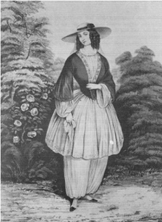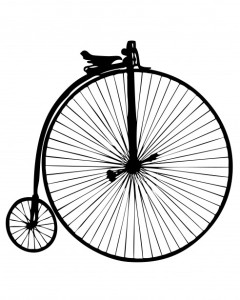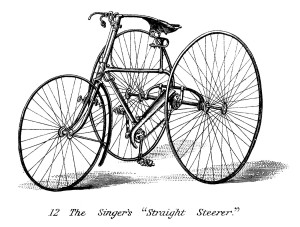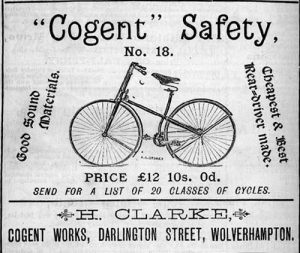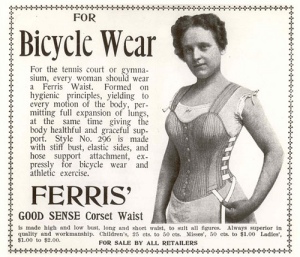Bicycles are AWESOME! They are fun. They give us exercise. They get us where we want to go. They are relatively inexpensive. It is precisely for these reasons that the bike should be counted as a hero in women’s history. The bike played a major role in the emancipation of women both legally and in fashion. When women started riding bicycles, back in the 1890’s, they started to get a taste for freedom, both from household life and from the long, heavy skirts and corsets that they were expected to bear.
In the mid-1800’s, women were considered fragile beings. (1) They fainted and got tired and sick easily. Nowadays we recognize that their clothing and lifestyle must have caused many of their maladies. They wore corsets that squeezed them in and made it hard to breath and move about. They wore long heavy skirts with layers of petticoats and other undergarments which overheated them. Sports were limited to ones that included mild walking, like croquet. Back then only a few brave women recognized the cause and effect of their attire.
The early Suffragettes tried to reform women’s dress in order to improve their health. In 1851, Elizabeth Smith Miller designed an outfit with Turkish style trousers and a knee length overdress. (2) When her friend Amelia Bloomer adopted and wrote about this outfit, the trousers became known as Bloomers. The concept of a woman wearing pants was too progressive for its time, however, and the women that wore them were highly ridiculed in the press and in public. There was a fear that women wearing pants could affect men’s moral values. (3) Women that sported the Bloomer Outfit were often treated like whores. Needless to say, many ladies chose to protect their reputation over the comfort of the new style. It faded within a few short years. Amelia Bloomer stopped wearing them when she decided that people would be distracted from her serious writing by her costume.
At this time, Bloomers and bicycles were still not related in any way. By 1851 the bicycle had already been invented but it was still in its infancy. Back then, there was only the first Velocipede, known as the Draisienne. (4) It was more like the toddler’s toy that we now know as the balance bike. It was made of wood, the rider straddled it and pushed himself along with his feet. There were no pedals.
The bicycle did not get its pedals until 1863 when another Velocipede, the Bone Shaker, (4) was invented. Women did not ride this highly uncomfortable device either. Its wheels were made of steel which meant a very bumpy ride over cobblestone streets. It was also hard to pedal because it was heavy and it did not have gears.
Next came the High Wheeler, (4) or the Penny Farthing in 1870. Neither did it have gears but the large, rubber front wheel allowed the rider to get more power from each turn of the pedal. It required less physical strength but more courage since it was dangerous. The seat was often two meters above the ground and difficult to mount. (5) Any obstacles in the way of the front wheel could send the cyclist flying forward, head first. Women, in general ,did not ride the Penny Farthing.
The first pedaled vehicle that women rode was the tricycle. (6) It was slow and safe and it accommodated their long skirts. It became popular in the early 1880’s.
In 1890, came the first bicycle that women wanted to ride, the Safety. (4) It had pneumatic tires, gears and both wheels were the same size. It was not very different from the bike that we now commonly ride.
1890 is also when bikes began to be mass produced in the United States. Both men and women were crazy about them, especially women. For women, they provided benefits that until then had been off limits. Independently women could easily travel farther from home and more safely on a bicycle than they had been able to do before. The aerobic exercise, a rare activity for females back then, also made them feel wonderful. 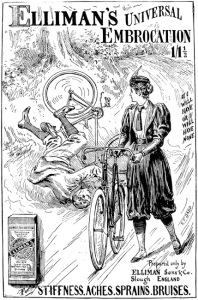 This newfound freedom threatened the male dominated status quo. Doctors warned that the bumpiness could damage delicate feminine organs and reproductive ability.(7) They developed medicines to cure the supposed illnesses caused by women cycling. People also worried that women might get sexually aroused or become lesbians by riding. Nonetheless, women had gotten a taste of freedom and of health. They ignored the warnings and rode.
This newfound freedom threatened the male dominated status quo. Doctors warned that the bumpiness could damage delicate feminine organs and reproductive ability.(7) They developed medicines to cure the supposed illnesses caused by women cycling. People also worried that women might get sexually aroused or become lesbians by riding. Nonetheless, women had gotten a taste of freedom and of health. They ignored the warnings and rode.
At first they continued to wear their skirts and corsets but those garments often got caught in the wheels and were uncomfortable. Before too long, a less restrictive corset had been invented with elastic and softer boning. Skirts shortened to above the ankle, at least for bicycling.
By 1894, the Bloomer Costume had come back as bicycle clothing. (8) Once again, the precursor to women’s pants was ridiculed. The ridicule, however, was no match for the love of riding that the first bloomer wearing cyclists experienced. They kept on sporting their bloomers and in a few short years, the bloomers were accepted as Rational Dress.(1)
Annie Londonderry, a young mother of three, played a major role in getting people used to seeing a woman in bloomers. (7) In 1895, she was the first woman to ride around the world on a bicycle. She was wearing skirts when she left Boston but soon switched to bloomers. She even wore men’s trousers occasionally on her trip.
Riding, and the independence that came with it, showed women that they were stronger than people had thought. It engendered a taste for liberation. In 1896, Susan B. Anthony said “Let me tell you what I think of bicycling. I think it has done more to emancipate women than anything else in the world. I stand and rejoice every time I see a woman ride by on a wheel. It gives woman a feeling of freedom and self-reliance.” (1)
THANK YOU bicycle! It is because of you that women got into pants and got out of corsets, bustles and long skirts. The joie de vivre and feeling of well-being that you gave women was stronger than her fear of rejection and stronger than the silly arguments that society made to dissuade ladies from riding. This first step was the seed that led women to doubt other silly ideas that they believed in the olden days. We no longer believe that women are inferior to men and should not be allowed to own property or to vote. Thank you also to all of the women that endured great ridicule in order to pave the way for the rest of us to ride comfortably in loose fitting, safe garments.
References:
1. “How the Bicycle Emancipated Women.” mental_floss. Mental Floss Inc. 8 August, 2008. Web. 7 May, 2015 http://mentalfloss.com/article/19373/how-bicycle-emancipated-women
2. “Amelia J. Bloomer.” Ohio History Central. Web. 7 May, 2015. http://www.ohiohistorycentral.org/w/Amelia_J._Bloomer
3. O’Malley, Soren. “The Importance of the Bicycle to the Early Women’s Liberation Movement.” Cranked Mag. Blog at WordPress.com. Web. 7 May, 2015. https://crankedmag.wordpress.com/issues/issue-4/the-importance-of-the-bicycle-to-the-early-womens-liberation-movement/
4. Mozer, David. “Chronology of the Growth of Bicycling and the Development of Bicycle Technology.” International Bicycle Fund. Dream Host. Web. 7 May, 2015. http://www.ibike.org/library/history-timeline.htm
5. James. “Penny Farthing: Facts and Information.” Primary Facts. primaryfacts.com. 23 July, 2014. Web. 7 May, 2015. http://primaryfacts.com/4785/penny-farthing-facts-and-information/
6. “History of Tricycles.” Tricycle Museum. wordpress.com. Web. 7 May, 2015. https://tricyclemuseum.wordpress.com/2-history-of-tricycles/
7. “Women on Wheels: The Bicycle and the Women’s Movement of the 1890’s.” Annie Londonderry. annielondonderry.com. Web. 7 May, 2025. http://www.annielondonderry.com/womenWheels.html
8. “A History of Bicycling.” Science of Cycling. Exploratorium. Web. 7 May, 2015. http://www.exploratorium.edu/cycling/timeline.html


